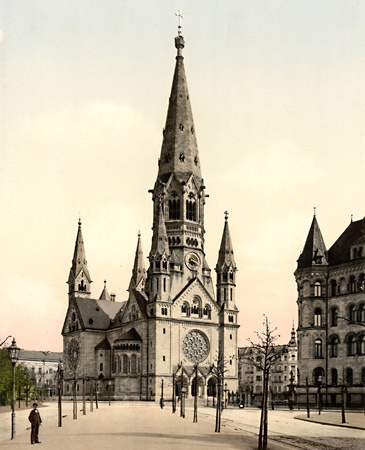Eiermann, Egon
German architect
born Sept. 29, 1904, Neuendorf, near Berlin, Ger.
died July 20, 1970, Baden-Baden, W.Ger.
 one of the most prominent German architects to emerge after World War II, whose wide variety of buildings have been admired for their elegant proportions, precise detail, and structural clarity.
one of the most prominent German architects to emerge after World War II, whose wide variety of buildings have been admired for their elegant proportions, precise detail, and structural clarity.Eiermann studied at Berlin Technical University under Hans Poelzig, later working in the building department of the Karstadt department store company. Beginning in 1930 he practiced architecture in Berlin and, from 1947, in Karlsruhe, where he also served on the faculty of the university. Adhering to an aesthetic of making order visible, Eiermann created a number of major achievements in functional design, including the textile mill at Blumberg (1951), the West German pavilion at the Brussels World Exhibition (with Sep Ruf, 1958), the West German embassy in Washington, D.C. (1958–64), and the IBM-Germany Headquarters in Stuttgart (1967).
Perhaps his most popular work is the Kaiser Wilhelm Memorial Church (1956–63), a symbol of postwar Berlin. Originally, a medieval revival building constructed in the late 19th century stood on the site, but after a World War II bombing raid only the bell tower remained. This ruin was incorporated by Eiermann into his strikingly simple design for a modern church.
- Sir Arthur Thomas Cotton
- Sir Arthur Thomas Quiller-Couch
- Sir Arthur Travers, 1st Baronet Harris
- Sir Arthur Travers Harris, 1st Baronet
- Sir Arthur Whitten Brown
- Sir Arthur William Currie
- Sir Arthur William Fadden
- Sir Arthur Wing Pinero
- Sir Astley Paston, 1st Baronet Cooper
- Sir Astley Paston Cooper, 1st Baronet
- Sir Augustus Wollaston Franks
- Sir Aurel Stein
- Sir Austen Chamberlain
- Sir Austen Henry Layard
- Sir Baldwin Spencer
- Sir Barnes Wallis
- Sir Bartle, 1st Baronet Frere
- Sir Bartle Frere, 1st Baronet
- Sir Basil Liddell Hart
- Sir Basil Spence
- Sir Basil Zaharoff
- Sir Benegal Narsing Rau
- Sir Benjamin Baker
- Sir Benjamin Collins, 1st Baronet Brodie
- Sir Benjamin Collins Brodie, 1st Baronet